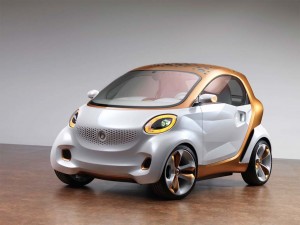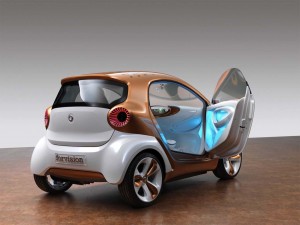Struggling Smart is offering up a vision of what could be the future of its two-seat Fortwo microcar.
The new Smart Forvision concept vehicle on display at the Frankfurt Motor Show is a long-delayed and much-needed replacement for a vehicle that has become increasingly outdated even as the competition floods the market with an assortment of hipper, more technically sophisticated alternatives.
The Forvision follows the unveiling of the earlier Fospeed cabriolet concept which was introduced at the Geneva Motor Show earlier this year.
“We’ve used all the tricks in the book,” said Thomas Weber, a senior executive with Smart parent Daimler AG, during the prototype’s preview in Frankfurt.
That notably includes finding a partner to help develop the microcar. In the decade since Smart launched Daimler has struggled to come up with a working business strategy for its smallest brand. It has lost billions on Smart and abandoned all earlier models but the Fortwo.
Going forward, the new business case will call for partnering with the Euro-Asian Renault/Nissan alliance. The partners have agreed to a variety of joint ventures, as TheDetroitBureau.com reported last week. (Click Here for more.) Among other things, the new Mercedes AMF platform used for the maker’s next-generation B-Class will serve as the foundation of a new Infiniti model based on the Etherea concept. Meanwhile, Renault’s latest microcar “architecture,” developed for its little Twingo model , will be shared with future Smart models – including the Fortwo replacement.
In concept form, the Forvision introduces a variety of intriguing technologies for the microcar segment – many of them developed with the assistance of yet another partner, German chemical giant BASF.
Those include plastic wheels that weigh about 7.5 pounds less than even aluminum wheels. A carbon-fiber epoxy resin was used for the passenger compartment and doors, meanwhile, reducing weight by 50% compared to steel and 30% versus aluminum. But the composite material is even stronger than conventional materials and would improve passenger safety if put into production, Daimler officials suggested.
The Forvision was shown in battery car form, underscoring the brand’s interest in electric technology. Some of the technologies shown in Frankfurt would prove particularly useful in the next-generation Smart Electric Drive, or ED.
For one thing, special insulation was used to reduce the power consumption of the Smart Forvision climate control system. Using a heater in the winter can reduce range of battery-electric vehicles, like the current Smart ED or Nissan Leaf, by as much as half.
How much of the Forvision concept will carry over into production remains to be seen. The lightweight resin materials will be a challenge considering their costs – which normally limit the use of composites to ultra-luxury vehicles – but manufacturers are pressing hard to drive down costs and improve manufacturability. BMW is betting on that as it prepares to launch its own battery-based sub-brand with models like the i3 and i8.
The all-new Smart is expected to reach showrooms sometime next year.
That’s none too soon for the little brand. Sales have been in a sharp slump, especially in the key U.S. market, despite rising fuel prices. Since its American introduction in 2008, sales are off by more than two-thirds and analysts remain skeptical whether even an updated version of the Smart Fortwo will reverse that decline.


